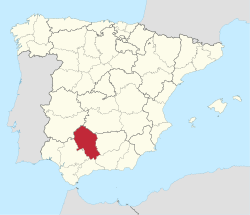Province of Córdoba (Spain)
Córdoba (Spanish pronunciation: [ˈkoɾðoβa]), also called Cordova in English,[1] is one of the 50 provinces of Spain, in the north-central part of the autonomous community of Andalusia. It is bordered by the provinces of Málaga, Seville, Badajoz (which is part of the autonomous community of Extremadura), Ciudad Real (which is part of the autonomous community of Castile-La Mancha), Jaén, and Granada. Its area is 13,769 km².
Córdoba | |
|---|---|
 Flag .svg.png) Coat of arms | |
 Map of Spain with Córdoba highlighted | |
| Coordinates: 38°00′N 4°50′W | |
| Country | Spain |
| Autonomous community | Andalusia |
| Capital | Córdoba |
| Government | |
| • President | Antonio Ruiz Cruz (PSOE) |
| Area | |
| • Total | 13,769 km2 (5,316 sq mi) |
| Area rank | Ranked 13th |
| 2.73% of Spain | |
| Population | |
| • Total | 800,000 |
| • Rank | Ranked 18th |
| • Density | 58/km2 (150/sq mi) |
| 1.78% of Spain | |
| Demonym(s) | English: Cordovan Spanish: Cordobés |
| Official language(s) | Spanish |
| Parliament | Cortes Generales |
| Website | dipucordoba.es |
History
A royal decree of November 30, 1833, created the Province of Córdoba (along with 48 other provinces),[2] which was formed by joining the towns of the Kingdom of Córdoba and the following towns until then located in Badajoz: Belalcázar, Fuente la Lancha, Hinojosa del Duque, and Villanueva del Duque.
Geography
Overview
The province is mainly divided into three geographical areas: the Sierra Morena to the north, the Baetic Depression in the center and La Campiña in the south.[3] The climate is continental Mediterranean with temperatures in the capital ranging from 9.2 °C in January and 27.2 °C in July and August, which often exceed 40 °C. Rainfall in the capital is recorded from 600 to 750 mm per year. It is concentrated from October to April. The Province of Córdoba ranks 11th in Spain in which the entire population is concentrated in the capital. On average, 31.96% of a Spanish province's population inhabits its capital. The province consists of 75 municipalities. They are further grouped into 8 “comarcas”.[3]
Its population is 799,402 (2014), of whom more than 40% live in the capital, Córdoba, and its population density is 58.06/km². The Province of Córdoba contains 75 municipalities. The province has three natural parks: Sierra de Cardeña y Montoro Natural Park,[4] Sierra de Hornachuelos Natural Park,[5] and Sierras Subbéticas Natural Park.[6] The University of Córdoba was founded in 1972.[7]
The province's capital city is a well-known tourist destination. Mezquita was built using pillars of uneven heights.[8] The city was declared a world heritage site in 1984.[9]
Comarcas
- Alto Guadalquivir
- Campiña Este - Guadajoz
- Campiña Sur
- Subbética
- Valle de los Pedroches
- Valle del Guadiato
- Vega del Guadalquivir
References
- Encyclopædia Britannica, Córdoba (conventional Cordova)
- Ford, Richard (2011). A Hand-Book for Travellers in Spain, and Readers at Home: Describing the Country and Cities, the Natives and Their Manners. Cambridge University Press. p. 96. ISBN 978-1-108-03753-2.
- "Introduction :Córdoba Province, Andalucia". Spanish News Today. Retrieved 30 September 2014.
- (in Spanish) Sierra de Cardeña y Montoro Natural Park
- (in Spanish) Sierra de Hornachuelos Natural Park
- (in Spanish) Sierras Subbéticas Natural Park
- Piñal, Francisco Aguilar (1991). History of the University of Seville. Universidad de Sevilla. p. 211. ISBN 978-84-7405-826-0.
- Watson, Fiona Flores. "The city of Cordoba". Andalucia.com. Retrieved 30 September 2014.
- Zee, Bibi van der. "Córdoba: the city that changed the world". The Guardian. Retrieved 30 September 2014.
External links
![]()
- (in English) Travel Guide to Cordoba Province
- (in Spanish) Page About Francisco Munoz